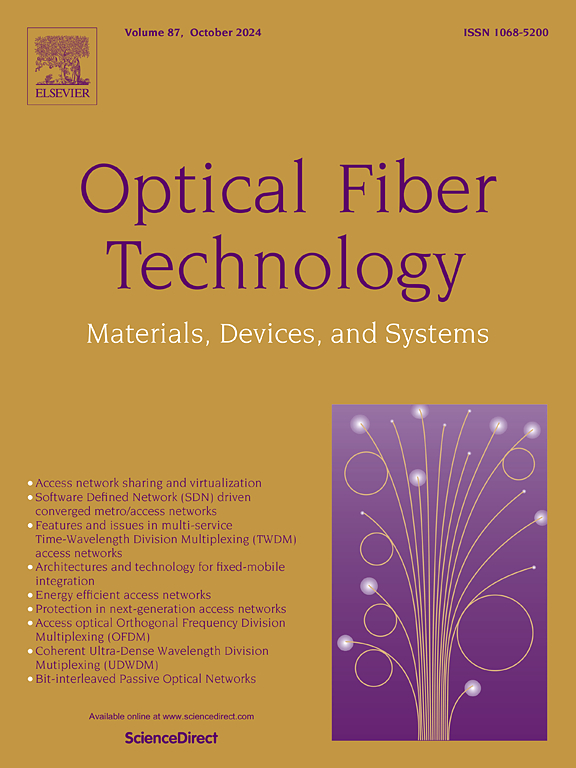GSADDQN: Combining GraphSAGE and reinforcement learning for routing optimization in software-defined optical transport network
IF 2.6
3区 计算机科学
Q2 ENGINEERING, ELECTRICAL & ELECTRONIC
引用次数: 0
Abstract
As a result of rapid development of network communication technology, optical transport network (OTN) traffic has also experienced rapid growth in terms of information volume scale, traffic complexity, and spatiotemporal distribution dynamics. Because the OTN traffic demand has complex spatiotemporal fluctuations, the traditional deep reinforcement learning (DRL) algorithm has been applied to the routing optimization of software-defined OTNs. However, the traditional DRL algorithm has problems such as slow convergence, weak generalization ability, and load imbalance when performing routine tasks. To address these issues, we propose a graph sampling and aggregation (GraphSAGE)-based dueling deep Q-network (GSADDQN) algorithm for software-defined OTN routing optimization. First, we design a DRL-based routing decision model to find the best routing strategy for each optical network’s source–destination traffic demand. Second, considering the sparse connection characteristics of optical network nodes, we use sampling neighbors and a deep aggregation mechanism as the neural network model of the Dueling Deep Q-Network (Dueling DQN) algorithm so that the reinforcement learning agent can consciously aggregate important network information and improve the model’s convergence performance and generalization ability. Finally, we design simulation routing experiments based on Gym and evaluate the algorithm’s load balancing and generalization capabilities for different network topologies. The experimental results show that the GSADDQN algorithm has good convergence performance and load balancing ability in routing optimization of optical transmission networks and can generalize new network structures, maintaining good decision-making ability even during network node failures.
GSADDQN:结合 GraphSAGE 和强化学习,优化软件定义光传输网络中的路由选择
随着网络通信技术的快速发展,光传送网(OTN)的流量在信息量规模、流量复杂性和时空分布动态性方面也经历了快速增长。由于 OTN 流量需求具有复杂的时空波动性,传统的深度强化学习(DRL)算法已被应用于软件定义 OTN 的路由优化。然而,传统的 DRL 算法存在收敛速度慢、泛化能力弱、执行常规任务时负载不平衡等问题。为了解决这些问题,我们提出了一种基于图采样和聚合(GraphSAGE)的决斗深 Q 网络(GSADDQN)算法,用于软件定义 OTN 路由优化。首先,我们设计了一个基于 DRL 的路由决策模型,为每个光网络的源-端流量需求找到最佳路由策略。其次,考虑到光网络节点连接稀疏的特点,我们使用采样邻居和深度聚合机制作为决胜深度 Q 网络(Dueling DQN)算法的神经网络模型,这样强化学习代理就能有意识地聚合重要的网络信息,提高模型的收敛性能和泛化能力。最后,我们设计了基于 Gym 的仿真路由实验,并评估了算法在不同网络拓扑结构下的负载平衡和泛化能力。实验结果表明,GSADDQN算法在光传输网络的路由优化中具有良好的收敛性能和负载平衡能力,并能泛化新的网络结构,即使在网络节点故障时也能保持良好的决策能力。
本文章由计算机程序翻译,如有差异,请以英文原文为准。
求助全文
约1分钟内获得全文
求助全文
来源期刊

Optical Fiber Technology
工程技术-电信学
CiteScore
4.80
自引率
11.10%
发文量
327
审稿时长
63 days
期刊介绍:
Innovations in optical fiber technology are revolutionizing world communications. Newly developed fiber amplifiers allow for direct transmission of high-speed signals over transcontinental distances without the need for electronic regeneration. Optical fibers find new applications in data processing. The impact of fiber materials, devices, and systems on communications in the coming decades will create an abundance of primary literature and the need for up-to-date reviews.
Optical Fiber Technology: Materials, Devices, and Systems is a new cutting-edge journal designed to fill a need in this rapidly evolving field for speedy publication of regular length papers. Both theoretical and experimental papers on fiber materials, devices, and system performance evaluation and measurements are eligible, with emphasis on practical applications.
 求助内容:
求助内容: 应助结果提醒方式:
应助结果提醒方式:


